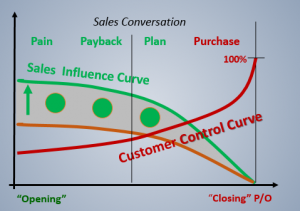Customers sign orders… so what do Sales people do?

Customers sign purchase orders…right? So how do we increase our sales influence? Why do sales managers often ask someone to ‘Go get that PO signed’?” In the end, the customer is the only one who can sign a PO, hence we could ask: So, what do Sales people do?
Well, asking that could be dangerous, but wait! Each opportunity has an “opening” and a “closing”. Buyers allow a lot of sales influence at opening – more than we might expect. Let’s talk about how Sales can manage this dynamic. First, think of a small graph (see diagram) with two curves that cross – the Customer Control curve rises from left to right and ends at 100% control at PO signing time.
The Sales Influence curve starts at 50% (or so…) then drops from left to right, ending at 0%. This is the orange curve. In the early days it is very elastic. In fact I believe we can dramatically increase our sales influence in the opening stages – illustrated by the green curve and the uplifting green arrow. How do we manage the “opening” better? Let’s get started.
“May I ask a few questions” is an opener we all can use during a customer meeting. The secret is – what is the specific direction for my questioning? The direction I recommend is to aim for digging deeper on 3 things – Pain points. Payback and Plan. These are represented on the diagram by three green circles. If you are a baseball fan think of these as the 3 bases – you need to touch all of them to score. Use these levers to elevate your “sales influence” during opening.
Sales influence – manage “opening” with 3 levers
Pain points – Explore the business drivers behind his/her conversation with you. It may be a big Problem-to-solve or a small one, but it is not just about your product. A strong opening requires you to learn about the application of your product, and who are the potential users. How are those people succeeding now, and how could they /should they succeed better? Why is it important to the buyer company? Write it down to gain greater influence, and send it to the buyer as followup. An email will suffice. Close it with a business bonding question like “Am I on the right track in my understanding?”
Payback – Every purchase needs a financial reason to proceed. Opportunities fail or stall if you accept “we have a budget” or any similar deterrent to discussing payback. Count how many users or business processes will become better with your solution – estimate a small uplift in results, and do the math. Again, share it in conversation, and again via email. Simple conclusions are most powerful as conversational items later – e.g. “… remember we estimated a $20,000/month positive impact once we get this project in motion.” Now you have again lifted the sales influence curve.
Plan – You will not be in the room for the final and most important sales meeting. Your champion may be alone with the decision maker, but won’t feel lonely when they have strong sales tools (…which you can help prepare). The ultimate sign-off person does not approve a product purchase. They approve a “Plan” to use your products, services and capabilities – and their own human resources. Help create a plan for what to do and when, with reasons based on your buyer’s Pain and Payback observations – dig out as many time drivers as you can. Then, use them to weave your plan into the fabric of how your champion will run a department, or a business unit – and do it far better.
With a stalled deal, avoid continued buyer followup aimed at “let’s get that PO signed”. It is better to point back to these “reasons to buy now” or confess they may not have been well built. Go back to square one, build or re-build these 3 critical levers, and try again with a fresh approach.



Follow Us
Follow us on LinkedIn for updates.